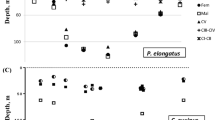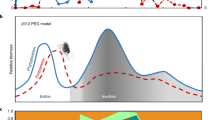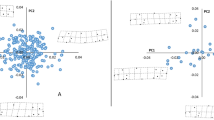Abstract
DIEL vertical migration (DVM) of zooplankton is generally considered to be a predator-avoidance strategy: zooplankton migrate to greater depths during the day to reduce their chance of being detected by visual predators (fish)1. Both phenotypic plasticity and interpopulational genetic variability in DVM patterns exist in zooplankton2,3. We used large indoor mesocosms ('plankton towers'4) to study intrapopulational genetic variation for day depth in a Daphnia hyalina X galeata hybrid population. Clones differing in body size also differed in vertical distribution, with the largest clone residing at the greatest depth during the day. A selection experiment in the presence of fish indicates that alternative anti-predator strategies, which involve a complex association between habitat-selection traits and life-history strategies, might be an important factor underlying intrapopulational genetic polymorphism in zooplankton, through a balancing of fitness effects in the presence of visual predators.
This is a preview of subscription content, access via your institution
Access options
Subscribe to this journal
Receive 51 print issues and online access
$199.00 per year
only $3.90 per issue
Buy this article
- Purchase on Springer Link
- Instant access to full article PDF
Prices may be subject to local taxes which are calculated during checkout
Similar content being viewed by others
References
Stich, H.-B. & Lampert, W. Nature 293, 396–398 (1981).
Neill, W. E. Nature 345, 524–526 (1990).
Neill, W. E. Nature 356, 54–57 (1992).
Lampert, W. & Loose, C. J. Arch. Hydrobiol. 126, 53–66 (1992).
Endler, J. A. Natural Selection in the Wild (Princeton Univ. Press, 1986).
Kerfoot, W. C. & Sih, A. (eds) Predation, Direct and Indirect Impacts on Aquatic Communities (Univ. Press New England, Hanover, 1987).
So, J. W. H. & Freedman, H. I. Bull. math. Biol. 48, 469–484 (1986).
So, J. W. H. J. Aust. math. Soc. B 31, 347–365 (1990).
Pijanowska, J., Weider, L. J. & Lampert, W. Oecologia 96, 40–42 (1993).
Zaret, T. M. & Suffern, J. S. Limnol. Oceanogr. 21, 804–813 (1976).
Lampert, W. Funct. Ecol. 3, 21–27 (1989).
Huntley, M. & Brooks, E. R. Mar. Biol. 71, 23–31 (1982).
Leibold, M. A., Tessier, A. J. & West, C. T. Evolution 48, 1324–1332 (1994).
Guisande, C., Duncan, A. & Lampert, W. Oecologia 87, 357–359 (1991).
Leibold, M. A. & Tessier, A. J. Oecologia 86, 342–348 (1991).
Lampert, W. & Sommer, U. Limnoökologie (Thieme, New York, 1993).
Ringelberg, J. J. Plankton Res. 13, 83–89 (1991).
Loose, C. J. Arch. Hydrobiol. Beih. Ergebn. Limnol. 39, 29–36 (1993).
De Meester, L. Ecology 74, 1467–1474 (1993).
Weider, L. J. Limnol. Oceanogr. 29, 225–235 (1984).
De Meester, L. Hydrobiologia 225, 217–227 (1991).
De Meester, L. Arch. Hydrobiol. Beih. Ergebn. Limnol. 39, 137–155 (1993).
De Meester, L. Oecologia 97, 333–341 (1994).
Ebert, D. Arch. Hydrobiol. (suppl.) 90, 453–473 (1993).
Tessier, A. J. & Consolatti, N. L. Oikos 56, 269–276 (1989).
Hedrick, P. W. A. Rev. Ecol. Syst. 17, 535–566 (1986).
Hebert, P. D. N. & Beaton, M. J. Methodologies for Allozyme Analysis using Cellulose Acetate Electrophoresis (Helena Laboratories, Beaumont, TX, 1989).
Rice, W. R. Evolution 43, 223–225 (1989).
Paloheimo, J. E. Limnol. Oceanogr. 19, 692–694 (1974).
Author information
Authors and Affiliations
Rights and permissions
About this article
Cite this article
Meester, L., Weider, L. & Tollrian, R. Alternative antipredator defences and genetic polymorphism in a pelagic predator–prey system. Nature 378, 483–485 (1995). https://doi.org/10.1038/378483a0
Received:
Accepted:
Issue Date:
DOI: https://doi.org/10.1038/378483a0
This article is cited by
-
The double-edged sword of inducible defences: costs and benefits of maladaptive switching from the individual to the community level
Scientific Reports (2022)
-
The great escape: Daphnia pulicaria from post-Bythotrephes invasion time periods have an enhanced escape ability
Hydrobiologia (2022)
-
Antipredator responses of the morphs of an amphibian species match their differential predation pressures
Behavioral Ecology and Sociobiology (2022)
-
Pharmacological modulation of fish-induced depth selection in D. magna: the role of cholinergic and GABAergic signalling
Scientific Reports (2021)
-
Phenotypic plasticity and developmental noise in hybrid and parental clones of Daphnia longispina complex
Aquatic Ecology (2021)
Comments
By submitting a comment you agree to abide by our Terms and Community Guidelines. If you find something abusive or that does not comply with our terms or guidelines please flag it as inappropriate.



